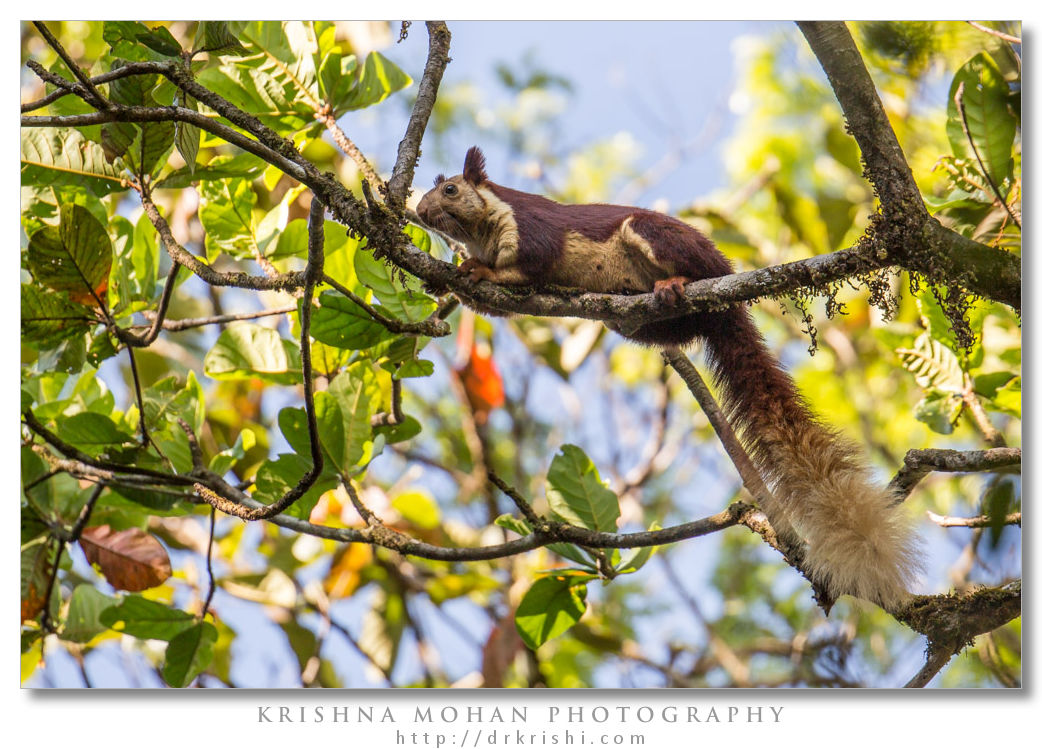
I came across this Malabar giant squirrel (Ratufa indica) at Kudremukh National Park.
Giant squirrels have always fascinated me. Unlike their constantly chattering, city slicking cousins, the palm squirrels, these gentle giants are elusive tree canopy dwellers, easily distinguished by their large size and a two to three toned, conspicuous color scheme. The head and body of this gorgeous animal can be up to sixteen inches long, with a tan colored tail measuring around two feet.
Rarely leaving their arboreal haven, giant squirrels travel by leaping from tree to tree and can often cover up to 6 meters in a single leap. On sensing danger, they prefer to flatten themselves against a tree trunk and freeze, rather than flee.
Crepuscular by nature, these gentle giants prefer to forage during the wee hours of morning and after dusk, resting during midday. Being shy and wary, they’re not often easy to spot and though they tend to live as monogamous pairs, solitary animals are not uncommon. Their nests are large (out of necessity) and globular, constructed on tall, thin branches in order to avoid predators, which include among others, various species of raptors and the ever accommodating leopard.

Ecological studies on Giant squirrels have pointed out the importance of , tall trees, canopy connectivity, contiguous forests and the presence of lianas for supporting viable population of the species. Apart from being an indicator species for structurally diverse forests, arboreal squirrels play an important role in seed-dispersal. Seeds constitute a major portion of their food, with bark, pith, flowers, fruit pulp and figs consumed as per their availability.
Squirrels are also known to assist in the germination of a few hardwood species by terrestrial seed hoarding and provide important food resources to avian frugivores in the vicinity. Fungi also forms an important part of their diet, thereby helping in the dispersal of myriad species of fungi in the forests they inhabit.
Malabar giant squirrels are endemic to Western Ghats, the Satpura mountain range and the Eastern Ghats. They’re seen at elevations of 180 to 2,300 m asl. Though they are widely distributed, they occur in several fragmented populations. Recent extinction of the species from tropical moist deciduous forests of the Surat Dangs, indicates that the Malabar Giant Squirrel is an extremely vulnerable species. The northern most distribution range for the species now starts from Maharashtra and extends southwards.

The species has been long been hunted throughout its range, not only for bush meat but also for the utilization of various body parts in quack medicine and for the pet trade. Other threats include habitat degradation due to fast encroaching large and small scale plantations, monoculture plantation, clear felling, selective logging and the construction of dams.
Thanks to Javed Ahmed for helping me to write this blog.


Hi Krishi sir,
Nice post on a much loved squirrel ! Saw them at Churna rest house in Satpura park in November.
Stumbled upon this paper: https://www.academia.edu/2237243/Comparison_of_Forest_Structure_and_Use_by_the_Indian_Giant_Squirrel_Ratufa_indica_in_Two_Riverine_Forests_of_Central_India
~Vivek.